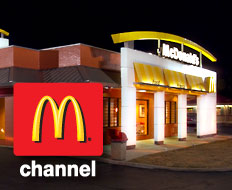After two years of testing in Los Angeles, San Diego, and Las Vegas, McDonald’s will launch its own in-store television network in 645 California stores later this year.
The McDonald’s Channel is expected to reach nearly 20 million people each month and integrate online and social-networking platforms. It will feature local content such as news, weather, and sports, as well as original features about local residents.
“This is where real estate meets social networks … [and] an opportunity to create a customer-facing application all about enhancing the customer experience,” says Lee Edmondson, founder of Los Angeles–based ChannelPort Communications, the McDonald’s Channel provider.
The in-store channel is part of McDonald’s push to become more relevant and contemporary, which has also included new store prototypes and premium menu offerings. It also counters Starbucks’ 2010 partnership with Yahoo! to offer exclusive online content inside its stores.
Edward Jones analyst Jack Russo sees the McDonald’s Channel as yet another step in the Oak Brook, Illinois–based company’s marketing evolution. As the company continues remodeling its dining rooms to create more comfortable, hospitable interiors—complete with WiFi, seating zones, and televisions—the network allows McDonald’s to dictate what diners view.
“Diners are a captive audience, and the intent is to hit customers with content McDonald’s wants them to see, which could make the brand recognition even stronger,” Russo says.
McDonald’s spokeswoman Ashlee Yingling cautioned that the Southern California roll out remains a test and that any future plans have not been determined.
“While we continue to look at making this branded content available to our customers, it would be premature to speculate on what additional restaurants [or] markets may be added to the test,” Yingling says.
The network was not a topic of conversation during McDonald’s third quarter earnings call on October 21.
Even so, Edmondson says McDonald’s Channel’s future could be bright.
“If all checks out [in Southern and Central California] and we get the customer experience we believe we can, then the opportunity and decision will have to be made as to when and how we scale this nationwide,” he says.
Whereas most marketing initiatives aim to drive traffic to stores, the McDonald’s Channel is perceived by many as a play to spark longer stays, upsell opportunities, and repeat counter visits.
The effort should also remind customers that they can be comfortable inside a McDonald’s much as they can in a Panera or Starbucks, two chains with welcoming dining room vibes.
“It’s the latest piece in the McDonald’s puzzle to keep the audience in the restaurant,” says R.J. Hottovy, senior restaurant analyst for investment analysis firm Morningstar.
Julie Hennessy, a marketing professor at Northwestern University’s Kellogg School of Management, says the network could bring valuable social currency to the Golden Arches.
The McDonald’s Channel could further entrench McDonald’s into consumers’ lives, particularly if the network becomes a long-term, nationwide piece of the McDonald’s experience, Hennessy says.
The grassroots content should also spotlight McDonald’s standing as a series of local businesses with owner-operators rather than a corporate monolith distant from Main Street.
But any large-scale venture like this inevitably demands dollars-and-cents rationale, she says.
“The question to be asked is, does this create value and fill a need for the consumer?” she says. “The channel is a big jump from McDonald’s traditional ways of creating value for consumers.”
The experts say there are still some unusual factors at play with the McDonald’s Channel, namely the company’s decision to invest significant capital in an area—the dining room—representing less than one-third of its business.
In addition, the venture features high start-up costs given the in-store hardware, including at least a pair of 42- to 46-inch HD televisions in each dining room and the expense of developing original content.
Although McDonald’s may have aligned itself with credible partners, producing content is not a trick already in its wheelhouse.
“Still, this is a small test and, therefore, not a massive risk,” Hottovy says, adding that he believes the pilot run is actually a smart use of capital. “With this measured approach, McDonald’s will be able to gauge customer interest before making more aggressive plans.”
In time, some say, the channel could become a revenue producer, should McDonald’s choose to pursue advertising on the network. Content partners and marketers could see the in-store channel as a novel way to reach consumer eyeballs.
Given the inquiring minds that examine McDonald’s every move, the success—or struggles—of the in-store channel should reverberate throughout the industry.
The potential of such a network might be greatest in quick-service restaurants with high dining room traffic, although post-recession fallout could delay any industry copycats. McDonald’s, after all, deals from a position of strength and remains one of the few quick-service brands with the muscle to embark upon such an ambitious plan.
Still, many stand convinced that McDonald’s pioneering ways will have a ripple effect across the industry, even if it’s a conglomerate approach in which various restaurant concepts join an in-restaurant network.
“If successful,” Hottovy says, “we’ll see imitations somehow, someway.”







